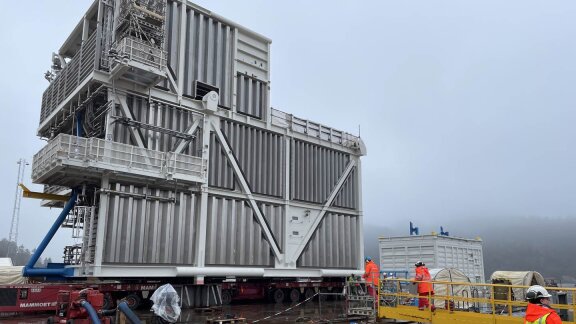Tommeliten feature
March 21, 2023
Every Tuesday at 6. am, Tommeliten A Project Manager, Jostein Sigvaldsen, gets in his car and drives from Stavanger to Aker Solutions` yard in Egersund. He wants to be close to the work on the project module and colleagues at the yard.
"This is the really exciting part of the job! Seeing the elements in the project come into production and the module become a tangible asset. As project director, I benefit from insight into what's going on at the yard and can more easily discuss the developments in the project with my colleagues here," Jostein says.
Now finished, the module project has been planned and executed in record time, and its installation is just around the corner. A range of disciplines have worked together to meet the deadlines set for the project.
“It's very good that Jostein comes down to work here every week during the project period. He sees with his own eyes what we have to consider in transforming engineering drawings into a physical module” says Håkon Phillip Refsland, FAB (fabrication) Project Manager responsible for following up module work in Egersund.
Jostein knows just how cramped and narrow workspaces inside the module have been for the workers, Håkon says.
Tommeliten A – the sail-away video
A special kind of work
When you know that over 100,000 workhours have been put into the module construction, the cramped module’s workspace takes on even greater meaning.
At the project’s peak, over 150 employees were doing engineering work in Stavanger and 200 specialists were engaged at the yard in Egersund. Now 100 of the latter work in offshore rotation to ready the module`s completion ahead of installation. In all, around 600 Aker Solutions employees have called Tommeliten Job No. 1.
By Friday, March 17th, 2023, the Tommeliten A process module was being rolled onto its barge at Egersund. As happens when rockets are launched into space, Jostein and Construction Manager, Håkon Phillip, joined a crowd of Tommeliten A team members and representatives from field operator, ConocoPhillips Skandinavia, to witness the module load-out.
The complexity of this project is like a car being modified while it’s being driven. The new facilities will be tied into a field while it’s producing.
Paal Eikeseth, Executive Vice-President and head of Aker Solutions' Electrification, Maintenance and Modifications (EMM) business.
“Seeing the module being moved onto the barge makes me proud to be part of Aker Solutions. I am very impressed by the effort everybody has put into this project, and how the Aker Solutions and ConocoPhillips teams have made this a success — together,” Jostein says
“To be a part of the project gives even more meaning when you know how pivotal it is to meeting the increased demand for gas in Europe,” he adds.
ConocoPhillips Skandinavia awarded Aker Solutions the topside modification contract for Tommeliten A in September 2021 after being asked in October 2020 to deliver the development’s subsea production system.
Quick turnaround
Tommeliten A is a subsea development comprising two subsea templates that can accommodate up to 12 production wells. The field facilities will be tied back to the Ekofisk Complex, where the new processing module will be installed.
“Aker Solutions has several decades of experience with these types of modifications and maintenance projects on the Norwegian Continental Shelf,” said Paal Eikeseth, Executive Vice-President and head of Aker Solutions' Electrification, Maintenance and Modifications (EMM) business.
The complexity of this project is like a car being modified while it’s being driven. The new facilities will be tied into a field while it’s producing.”
In less than two years, the project has gone from front-end engineering and deisgn (FEED) studies to Module completion.
“Time has been short from the drawings arriving at the yard to production start, making close collaboration between all the contributors in the project even more important. Less time for preparations increases the risk for delays during construction. If we had a normal time schedule, we could have managed material delays better,” says Sigvaldsen.
Challenges overcome during the project involved pipe deliveries, valves and mechanical equipment that delayed the start of piping prefabrication by six weeks.
“We are now approaching the finishing line and the team collaboration across different locations and disciplines has been the key for success” Sigvaldsen concludes.